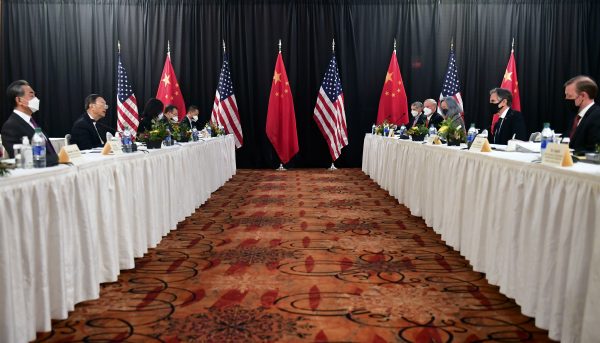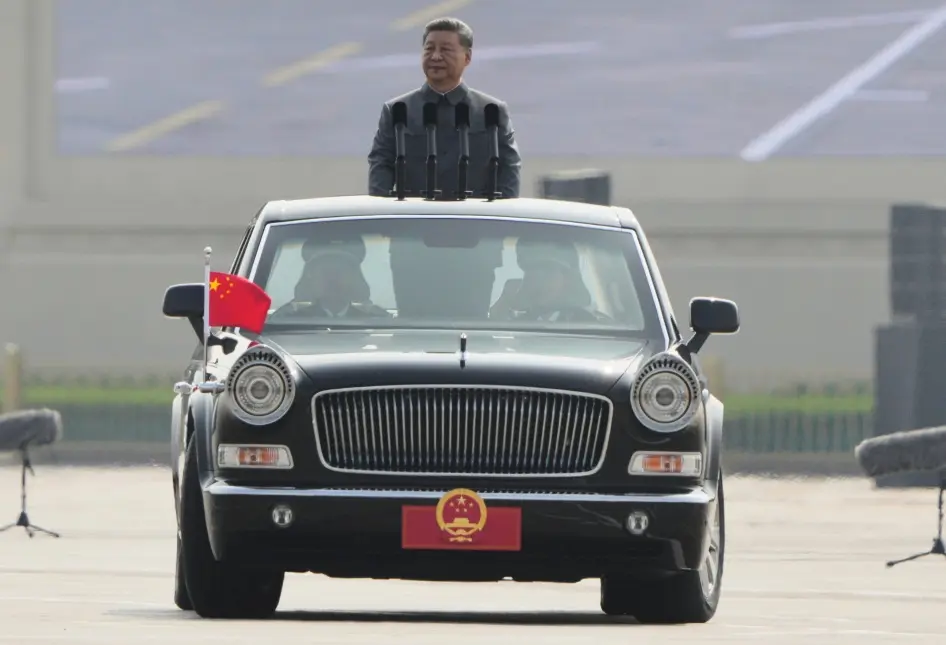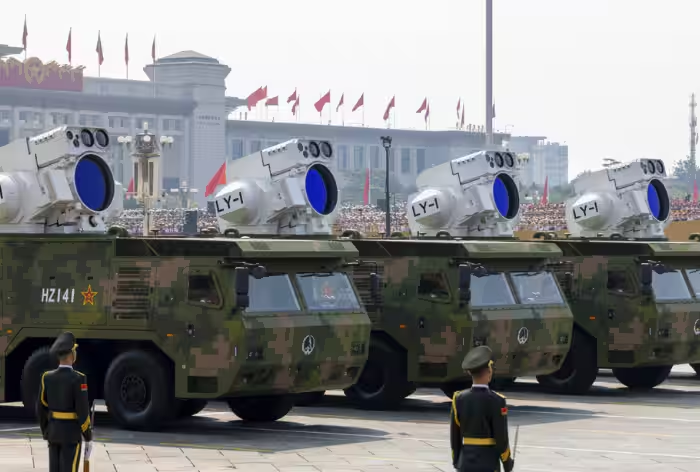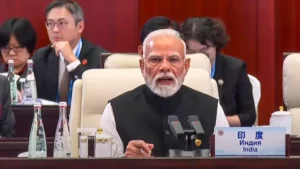The Modern China-Russia-US Triangle
In this March 18, 2021, file photo Secretary of State Antony Blinken, second from right, joined by national security adviser Jake Sullivan, right, speaks while facing Chinese Communist Party foreign affairs chief Yang Jiechi, second from left, and China’s State Councilor Wang Yi, left, at the opening session of US-China talks at the Captain Cook Hotel in Anchorage, Alaska.
Since the beginning of the Cold War, great power interactions among the United States, China, and Russia/the Soviet Union have always played a predominant role in international relations. For the most part, whether during the years of Sino-Soviet alignment or the historic “Nixon to China” moment, this has involved two sides aligning against the other. Warmer relations between China and Russia in response to the current U.S. policy of strategic competition suggest a continuation of this trend. Upon analyzing the modern configuration of this so-called “triangle,” however, this assessment merits further examination.
As the China-U.S. relationship locks itself into a seemingly irreversible trajectory of strategic competition, “Cold War 2.0” has become a rather popular buzzword. It is important to note, however, that while certain characteristics of modern strategic competition do bear some resemblance to those of the Cold War, this era of globalization means that a long-term global showdown between Washington and Beijing is likely to transpire not in a bipolar order, but a multipolar one, in which complex, intertwined interests among nations will factor into almost every aspect of strategic competition.
In this multipolar order, while more evenly distributed with the rise of the European Union, India, and Japan, among others, power remains heavily concentrated in the hands of a so-called “triangle,” of which the United States and China command two sides, with the third occupied by Russia. Although their demographics and economy are by no means trending toward sustained global power status, Russia’s nuclear arsenal and military might, coupled with an assertive foreign policy and global presence, still guarantee their place at the table, or in this case, in the triangle.
China and Russia Aligned
In recent years, as the U.S. has ratcheted up pressure against each of its perceived strategic competitors, China and Russia have been stepping up bilateral cooperation across multiple domains, while closely working together to offset U.S. pressure, counterbalance U.S. influence in multilateral forums, and rebuke the U.S.-led international order. In fact, just last week, Russian President Vladimir Putin, in a phone call with China’s top diplomat Yang Jiechi during his visit to Russia, exclaimed that relations between the two countries were “the best in history.”
Enjoying this article? Click here to subscribe for full access. Just $5 a month.
This trend has not gone unnoticed among scholars and policymakers, especially in Washington. U.S. officials under both the Trump and Biden administrations have frequently sounded the alarm about closer China-Russia ties. Most recently, the U.S. intelligence community in its “Global Trends 2040” report assessed that China and Russia “are likely to remain aligned” in the future.
But how aligned, exactly?
Diplomat Brief Weekly Newsletter N Get briefed on the story of the week, and developing stories to watch across the Asia-Pacific. Get the Newsletter
On the one hand, this China-Russia alignment should not be written off merely as a temporary “marriage of convenience” filled with unresolved distrusts that can easily crumble from within. The comprehensive strategic partnership between China and Russia is based on long-standing framework of cooperation, with a clear strategic objective set out in their 1997 “Joint Declaration on a Multipolar World and the Establishment of a New International Order” and 2001 “Treaty of Good Neighborliness and Friendly Cooperation.” As long as both countries remain at odds with the United States and the West, they will likely maintain enough incentive to overcome issues of the past and jointly push toward a more favorable international order.
On the other hand, this partnership does have its fair share of limitations. Despite sharing a deep disdain for U.S. hegemony and the Western-led international order, China and Russia lack symmetrical interests for natural and sustained cooperation, especially as the disparity between Russia’s low economic complexity and dependence on natural resources relative to China’s diverse and modern economy becomes more evident. A majority of Russia and China’s overlapping economic interests are in energy, due to Russia’s need for a stable market to offset Western sanctions, coupled with China’s growing energy demand and a desire to diversify its energy sources in response to prolonged trade tension with the United States.
It is fair to say, then, that while China and Russia do enjoy an enduring and extensive relationship, the strength of their alignment still hinges quite heavily upon U.S. policies. In fact, the Global Times, a Chinese state-owned newspaper, went as far as to attribute closer China-Russian ties to “the U.S. and its main allies’ suppression of the two countries” in a recent editorial.
But what happens when there is no longer any such “suppression”?
From “Two Against One” to “One Against One Plus One”?
It is important to note that, while both China and Russia have endured their fair share of strains in relations with the U.S., neither has shown the willingness to risk a complete rupture with the world’s only $20 trillion economy. When the time comes, cooperation with the U.S. usually takes precedence. This mindset was clearly in effect around the time the U.S. paved way for China to join the WTO in 2001, or when the Obama-Medvedev administrations pushed toward a “reset” (2009-2011). Back then, China-Russia cooperation seemed to have taken a back seat.
Fast forward to today, and negative domestic sentiment toward China and Russia, as well as perceived threats from both to American supremacy, have firmly locked the U.S. into a path of strategic competition with each of these rivals. That said, being locked in a strategic competition in the context of today’s globalization is fundamentally different from being locked in the zero-sum blocs of the Cold War, where alignment pretty much equated to alliance.
This, along with a lack of resources necessary for full-scale, simultaneous clashes with both China and Russia, explains why the U.S. does not rule out cooperation with its competitors. However, as Beijing currently presents a much more comprehensive and structural challenge to Washington, the Biden administration is prioritizing cooperation with Moscow in areas of mutual interests. Hard-line policies toward Russia remain in place, but they are largely symbolic and designed to appease anti-Russia domestic sentiment. Actual results, such as the extension of the New START, an early phone call between the two presidents, or the recent U.S. decision to waive sanctions for the Nord Stream 2 pipeline, suggest an overarching goal of what U.S. Secretary of State Antony Blinken has described as “a stable and more predictable relationship” with Russia.
Enjoying this article? Click here to subscribe for full access. Just $5 a month.
Here we’re witnessing an interesting triangular dynamic playing out. While the China-U.S. competition arc is pretty much a lock, both sides are courting Russia. As the United States continues to rally its allies and partners around a rules-based international order that portrays China and Russia as the “bad guys,” China is in a much better position to align with Russia. However, Washington retains its own share of leverage in relations with Russia, most notably a significant influence over allies in Europe – a crucial theater, if not the most crucial theater, of Russian foreign policy.
In other words, the dynamic is not as much “two against one” as it is “one against one (U.S. versus China) plus one (Russia).” Unlike the concrete alliances of the Cold War, modern alignments offer a much greater deal of flexibility, allowing Russia to pick its spots and simultaneously engage with both the U.S. and China, instead of having to stick to one side at a time in the case of China throughout the Cold War.
Looking Ahead: The Constant and the Variable
In the context of sustained globalization coupled with a growing disparity in power between the U.S. and China relative to Russia, this modern configuration of this triangle should persist for years to come. The U.S. and China, superior in total power and locked in a long-term strategic competition, will serve as the “constant.” Russia, meanwhile, will assume the role of the “variable,” seeking not to go toe-to-toe with the other two, but rather to utilize its leverage and manipulate the balance of power to its advantage.
Going forward, while focusing its resources on competing with China, the United States will attempt to stabilize relations with Russia and keep China-Russia engagement at a manageable level, ensuring that the Russian “variable” does not upset the overall balance of power in the triangle, as well as on a global scale. It’s unlikely that there will be a modern “Biden to Moscow” moment anytime soon, but the upcoming Biden-Putin summit in Europe will present an opportunity for Washington to lay out clear terms under which to engage Russia in a way that does not alienate their European allies or suggest any reversal from their overall message.
Similarly, China will continue to prioritize competition with the U.S. while further deepening cooperation with Russia, leveraging a seemingly cordial relationship between their leaders into new alignment of interests bilaterally and coordinated efforts against the U.S. multilaterally, even offering attractive economic incentives to lure Russia closer to their orbit. On the other hand, Beijing will not seek confrontation with Washington, and is likely to pursue cooperation on global issues such as climate change, COVID-19, or nonproliferation.
As for Russia, the key is to maintain its place at the table (or triangle) despite falling behind economically. That means continuing to leverage its “variable” role in triangular interactions, engaging with Beijing and Washington in order to extract concessions from both sides. However, Russia’s innate nationalistic pride, coupled with a severe lack of strategic trust with regard to the other two powers, will continue to limit the scope of future cooperation, especially as it pertains to areas within Russia’s perceived influence such as Central Asia or Eastern Europe.
Global and Regional Implications
Generally speaking, this triangular dynamic of great power competition in the context of globalization presents both opportunities and challenges to the world’s small and middle-sized countries.
If it is properly managed and trends toward a more predictable path with limited confrontation, this triangle should provide a favorable environment for countries outside of it to simultaneously pursue cooperation with each “side” without having to always look over their shoulders in fear of provoking the other(s).
On the other hand, if tension escalates and recent drumbeats regarding a so-called contest of “democracies versus autocracies” continue to take hold, thus breaking the core essence of the triangle and turning competition into an ideological battle, then other countries will be forced into picking sides. Globalization will more than likely prevent this undesirable outcome, but the risks should not be taken lightly.
Among regions, while Europe and the Middle East will continue to be of significant importance to policymakers in China, Russia, and the United States, the Indo-Pacific should emerge as the main theater of great power competition, if it hasn’t already – especially as West-to-East economic and military shifts become more evident.
It is important to point out that the majority of countries in the region have throughout their rich histories become used to being part of armed conflicts between, or in certain cases, against global powers. Though each country has its unique interests, all share a national security priority of maintaining peace. So while big power competition that leads to a more prosperous Indo-Pacific is more than welcome, it should not come at the cost of security and stability.
Therefore, it should be of paramount importance that the triangle operates in sync with regional interests. That means respecting regional mechanisms such as ASEAN, treating countries in the region as true partners of mutual interests instead of geopolitical pawns, and further contributing to peace, security, and prosperity in the region. Should countries in the triangle manage to compete with restraint, to clash while accepting each other’s legitimate interests, and to fight for influence yet also facilitating cooperation for the common good, a new concert of powers might be in the works.
This should be music to the ears of leaders across the region.












